ARTICLE AD BOX

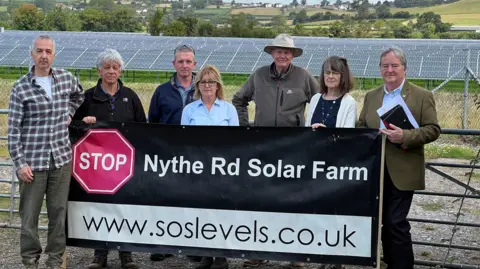 BBC
BBC
"When it's gone, it's gone," say campaigners fighting to keep farmland for food
Should rural land be used to produce food or energy? It is a question that divides farmers nationwide, and is being debated on the Somerset Levels.
On ancient grazing pastures steel and silicon solar panels are being installed, taking thousands of acres of farmland out of food production.
Across the country, the new Energy Security Secretary, Ed Miliband, has already approved three huge controversial developments, covering 6,200 acres (2,500 hectares) of farmland.
And while some farmers see solar as offering financial stability, others fear the loss of the land that feeds us.

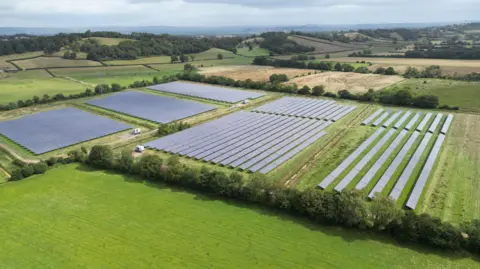 BBC/Andrew Roberts
BBC/Andrew Roberts
A new solar farm proposed for this site in Somerset would be four times bigger than the current one
Mr Miliband wants to quadruple UK solar power, which he says will "make the UK a clean energy superpower."
Some farmers are happy to rent their fields to the growing green energy industry.
Others are joining forces with campaigners fighting to keep farms for food.
“We’re losing so much of our farmland,” said Hugh Williams, of Somerset Campaign to Protect Rural England (CPRE).
“Once it has gone, the damage is done.”
So why do farmers agree to put their fields under silicon panels? And will it mean Britain has to import more food?
How much does solar pay?
Every week, Sam Small and her family turn down thousands of pounds of guaranteed income. They farm 400 acres on the Somerset Levels, five miles west of Glastonbury.
When I visited her by the immaculate cow sheds, the sun was out - and she could earn a healthy income from that solar power.
Mrs Small showed me a stack of adverts and emails the family have received.
“We get plenty of emails saying, ‘Make a thousand pounds an acre from your land!' They're everywhere now.”

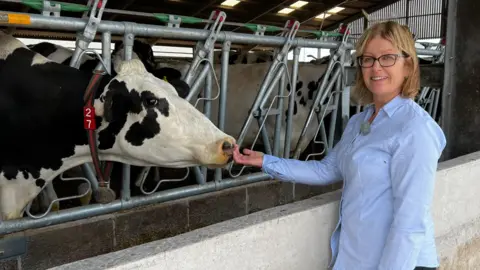
"We need every acre to feed these cows", said dairy farmer Sam Small
If they rented out just a 10th of their land to a solar energy firm, they could earn £40,000 a year.
For 30 years.
For doing nothing.
But Mrs Small just laughs at the idea.
“Very tempting,” she smiles, “but 10% of our land will also feed these cows. You have to look at the bigger picture.
"We produce nearly two million litres of milk a year, and that is what we intend to carry on doing."

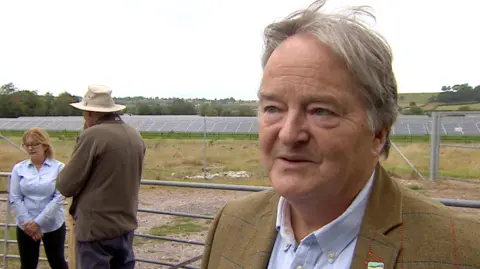
"We're losing so much farmland," said Hugh Williams of Somerset CPRE
As well as refusing to put her land under solar panels, Mrs Small has joined a local campaign group fighting a nearby development.
Elgin Energy applied to build a 146-acre (60 hectare) solar park at Nythe Rd, near Pedwell, producing enough energy to power 17,000 homes.
There is already a smaller solar installation on the same farm, covering around 40 acres.
Hundreds of local residents also objected, many citing the loss of productive farmland.
"This was a thriving dairy farm", said Lorna Hattingh.
"To destroy farmland that is being used for food just seems a really negative way of doing it."
Mr Williams, from CPRE Somerset, joined the group for the same reason.
"We only produce 60% of our food in this country," he said.
"No-one talks about the carbon footprint of the 40% we import. We’ve had food prices through the roof, we don’t seem to have learned the lessons of relying on food imports.
"And we keep taking farmland away. Why?"
The campaign was successful. In May Somerset Council rejected the solar park proposal, citing a "failure to explore lower quality agricultural land" among its reasons.
But campaigners expect the developers to appeal.
At Washford, on the Somerset Coast, the same company had a 132-acre project rejected by Somerset Council, but then won an appeal and will soon start building.
How much land is going under solar?
There are dozens of similar schemes in the West Country.
- Near Milverton, on the edge of the Quantock hills, another 76 acres of farmland has been approved for a solar farm, this time powering up to 7,000 homes.
- On the Somerset/Wiltshire border, a bigger solar park covering 184 acres of farmland has been proposed.
- In North Wiltshire, 8,000 people objected to a plan for 2,000 acres of solar panels called Lime Down.
Across the UK, it's the same story. Dozens of medium-sized solar parks covering hundreds of acres are popping up.
But there are plans for much much bigger schemes, like the three contentious plans recently approved by the new government, totalling more than 6,000 acres.
On the Cambridgeshire/ Suffolk border Sunnica Energy got the green light in July for a 2,500-acre solar park.
Campaigners argue that vast swathes of British farmland is being turned over for solar power use, never to be farmed again.
But are they right?

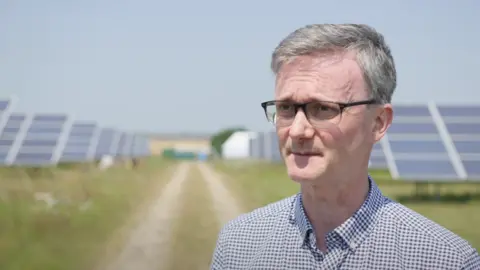 Solar Energy UK
Solar Energy UK
Chris Hewett of Solar Energy UK insists the industry needs less than 0.5% of UK land
"We actually need a tiny amount of land," said Chris Hewett, Chair of Solar Energy UK.
He speaks for the solar energy industry, and welcomes the new government's enthusiasm for photovoltaic (PV) power.
"We need less than half a percent of UK land, for a fully decarbonised energy grid.
"That is the amount of land we use for golf courses – and less than we use for airports."
Could solar save farming?
Plenty of people think fields of solar panels could actually be the financial saviour of British farming.
One farmer has learned that first hand, over 12 years.
On the other side of Somerset, Patrick Twigger was trying to get the harvest in when I arrived.
"It's still a bit damp", he smiled ruefully, "but we've got to get this wheat in before it rains again."

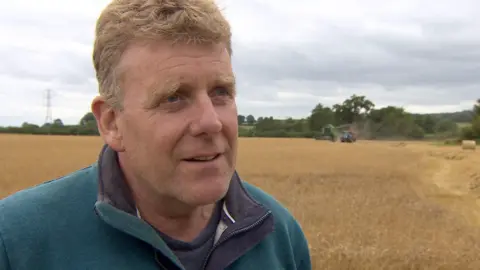
Patrick Twigger says the solar panels on his farm provide vital secure income
The combine and tractor team worked hard, one eye on the darkening clouds.
"Too wet, too dry, too hot, too cold - we're always battling against the weather!" Mr Twigger said.
Like so many farmers, he has had a particularly tricky year of weather. The wheat he grows to feed his pigs will be smaller, and damper, than he would like.
Other crops failed, and there was plenty of flooding on his farm near Frome.
But some fields earn him money every year, come rain or shine.
Twelve years ago he rented out 40 acres to a local solar energy firm.
The panels in his fields make enough electricity to power about 3,000 homes.
"It's become a more important income than it was 10 years ago," added Mr Twigger.
"With the rising cost of fuel, electricity, wages, insurance, the solar has become a very important part of the farm."

 BBC/ Andrew Roberts
BBC/ Andrew Roberts
The solar fields are a small part of the whole farm, but provide financial security
Mr Twigger cannot reveal how much the solar energy firm pays for his land.
But offers between £800 - £1,000 per acre are common.
How does that compare with any other crop?
Louis Smith is an experienced rural accountant at the advisory firm Old Mill.
I asked him to compare solar with wheat, the most profitable crop farmers grow in the South West.
He explained: "In a phenomenal year you might hope for four tonnes of wheat per acre, which would give you a gross revenue of £600-£800 an acre, depending on the price. So after costs, you might make £200 an acre profit."
Solar schemes are, he calculates, four or five times more profitable.
The government wants to quadruple the amount of solar energy made in Britain, from 15 gigawatts now to over 70 GW by 2035.
Plenty of farmers will be offered a solar sweetener. Few would want to put all their fields under panels, and there are tax consequences of doing so.
But a part of the farm? Mr Smith is quite clear.
"If you can get financial stability in your business, surely that’s what everybody is after?"

 8 months ago
32
8 months ago
32
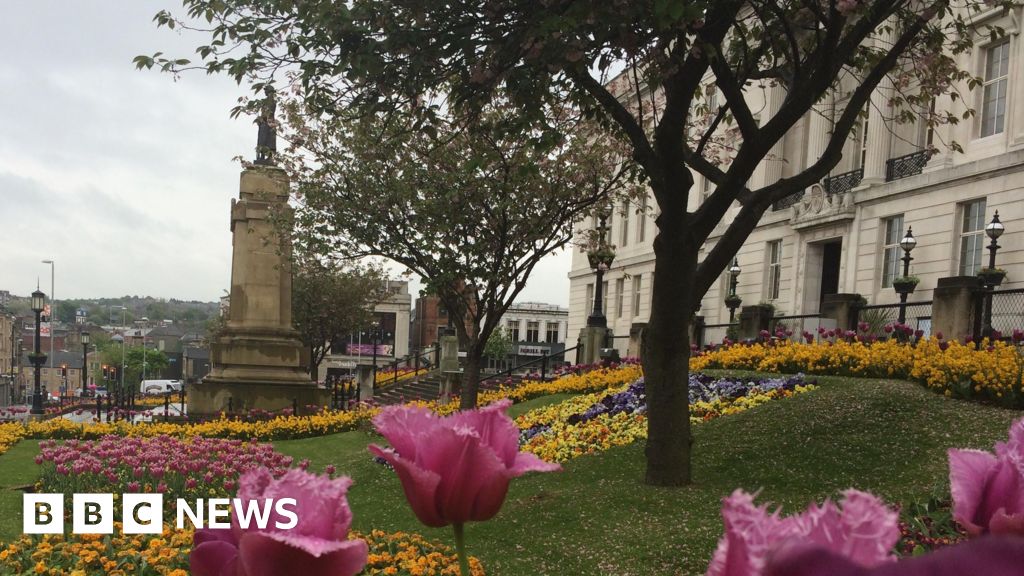







 English (US) ·
English (US) ·